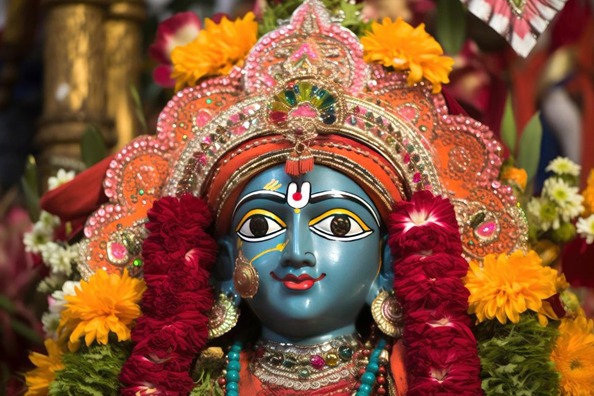Embracing the Jolly Radiance of Shree Krishna: The Epitome of Divine Playfulness

In the vast expanse of Hindu mythology, the figure of Shree Krishna stands as a beacon of joy and love, radiating a jolly and lovable nature that captivates the hearts of devotees. As the eighth avatar of Lord Vishnu, Krishna’s divine playfulness transcends the conventional boundaries of deity worship, inviting a profound connection with his devotees. His childhood tales, particularly those chronicled in the revered scripture “Bhagavad Gita,” depict a multifaceted persona that encompasses mischievous pranks, profound wisdom, and an unwavering commitment to righteousness.
Contents
Krishna in Vrindavan
Krishna’s childhood in Vrindavan is a tapestry of playful escapades, with tales of him stealing butter, playing enchanting tunes on his flute, and engaging in lively dances with the gopis. These anecdotes, collectively called “leelas,” these leelas symbolize the lovable and jolly essence of Krishna. His playful interactions with the gopis, especially the beloved Radha, unfold as symbolic expressions of divine love, transcending the earthly and embracing the spiritual.
The lovable nature of Shree Krishna extends to his interactions with the cowherd community in Vrindavan. His ability to convert every mundane task into a joyful celebration, such as the Raas Leela (dance) with the gopis or the lifting of Govardhan Hill to protect the villagers from Indra’s wrath, exemplifies the divine playfulness that defines Krishna’s character.
Krishna’s Playful Leadership
Krishna’s youthful endeavors are not limited to Vrindavan. As he matures into a charismatic leader and prince, his playful charm persists. The tales of Krishna’s exploits in Mathura, where he defeats the tyrant King Kansa, showcase not only his valor but also his ability to confront challenges with a joyful spirit. The divine playfulness that accompanies Krishna’s heroism in these narratives adds a unique dimension to his character, making him relatable to devotees across generations.
One of the most cherished aspects of Krishna’s playfulness is his divine flute playing. The melodious tunes that emanate from his flute have a captivating effect, symbolizing the call of the divine to the souls. The imagery of Krishna playing the flute under the moonlit sky in Vrindavan has become an iconic representation of his enchanting and jolly persona. The flute, an extension of his playful nature, is not merely a musical instrument but a conduit for connecting with the divine.
How Many Wife of Krishna: Exploring the Divine Energy
how many wife of krishna?; In Hindu mythology, Shree Krishna is celebrated for his divine love and companionship with multiple wives. According to traditional beliefs, Krishna had 16,108 wives, with Queen Rukmini being his principal queen. The circumstances surrounding Krishna’s multiple marriages are rooted in the narrative of the Yadava princesses being held captive by the demon Narakasura. Krishna, in his valorous form, rescues these princesses and for the matter of respect and integrity the princesses asks Krishna a way out from this mentally disturbing fact of them getting kidnapped by the demon for sinfull reasons, out of compassion and to make them free from this mental burden Krishna proposes all of them for marriage and marries them to restore their honour and social standing.
While Rukmini holds a special place and lived along the side of Lord Krishna, Krishna’s marriages are diverse and include queens like Satyabhama, Jambavati, Kalindi, and others. Lord Krishna is famous for his equal love for all his thousands of wives. Each marriage is embedded in unique stories and circumstances, reflecting Krishna’s multifaceted relationships and the diverse symbolism associated with his consorts.
Krishna’s marriages are not merely a display of divine love but also convey profound spiritual messages. His union with Rukmini symbolizes the ideal of a devoted and steadfast spouse, while his marriage to Satyabhama portrays the essence of passionate love. The diversity in Krishna’s consorts represents the multiplicity of paths that lead to the divine, acknowledging that love and devotion come in various forms.
The Connecting Link of Lord Krishna with his Devotees
Worshipping Lord Krishna at home through a Krishna idol brings manifold benefits to devotees. The presence of a Krishna idol creates a sacred space, fostering an atmosphere of peace and spiritual serenity. Devotees often engage in rituals such as daily aarti (lighting lamps), offering flowers, and chanting mantras, enhancing their connection with the divine. The Krishna idol serves as a tangible representation of love, joy, and divine wisdom, inspiring a sense of devotion and reverence. The act of worship deepens one’s spiritual consciousness, instills a sense of purpose, and invites the blessings of Lord Krishna into the household, promoting harmony and well-being.
Conclusion
Shree Krishna’s jolly and lovable nature permeates every aspect of his divine playfulness, making him a relatable and cherished deity. His enchanting tales, marked by mischievous pranks, divine wisdom, and a deep sense of love, resonate with devotees as a source of joy and spiritual inspiration. Krishna’s myriad consorts further exemplify the inclusive and diverse nature of divine love, showcasing that the path to the divine is as varied as the colors of his playful leelas.




